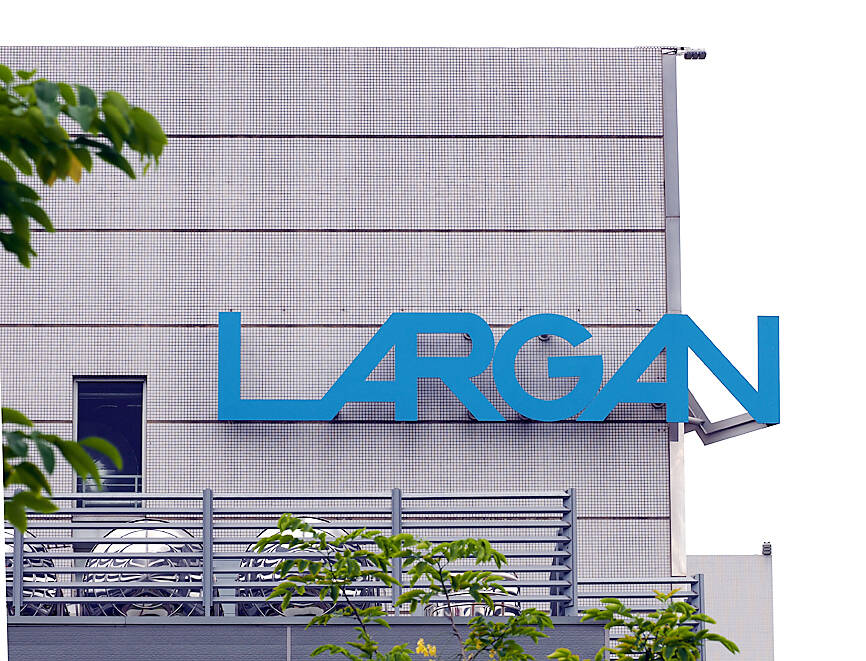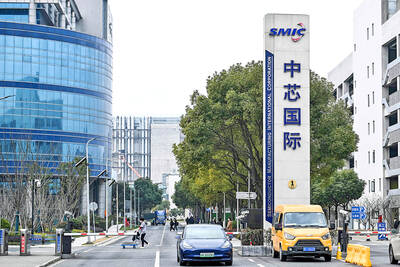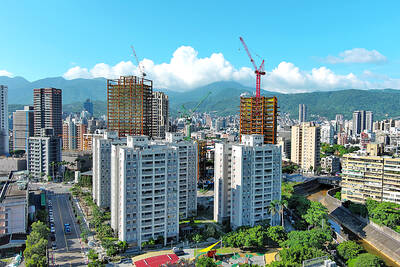Largan Precision Co (大立光), the nation’s leading handset camera lens maker, on Saturday reported a 28.87 percent year-on-year increase in consolidated revenue for the first quarter of this year to NT$14.58 billion (US$44.06 million).
The figure surpassed market expectations, with Capital Investment Management Corp (群益投顧) forecasting NT$14.3 billion and SinoPac Securities Investment Service Corp (永豐投顧) projecting NT$13.77 billion.
However, the figure still fell 19.4 percent from the previous quarter’s NT$18.21 billion as the industry entered its slow season, analysts said.

Photo: David Chang, EPA-EFE
Largan, a technology leader in the high-end smartphone camera lens market, reported earnings per share of NT$194.17 last year, the highest since 2019, driven by trends such as higher camera resolution migration, and growing adoption of periscope and telephoto lenses.
Beyond smartphones, the Taichung-based company has also tapped into new sectors, including the humanoid service robot market, where it has begun sending plastic lens samples to several customers.
Largan has also begun designing camera lenses for robotic arms used in factory automation, executive officer Adam Lin (林恩平) said at an earnings conference on Jan. 9.
The company said that revenue for this month would be lower than last month’s NT$4.89 billion due to seasonal factors.
Largan is to hold an earnings conference on Thursday to release its financial results for the last quarter and provide sales guidance for this quarter. The company is also expected to shed light on lens technology trends for foldable phones, slimmer handsets and artificial intelligence-powered devices.
The market is also expected to focus on the company’s plans for production capacity strategy and its response to the newly imposed tariffs by US President Donald Trump.
As a key supplier to Apple Inc, Largan has been drawn into broader concerns about potential supply chain disruptions.
Apple last week saw the largest two-day loss in shareholder value on record following Trump’s tariff announcement, amid fears about supply chain disruption and the impact on its profit outlook.

NO BREAKTHROUGH? More substantial ‘deliverables,’ such as tariff reductions, would likely be saved for a meeting between Trump and Xi later this year, a trade expert said China launched two probes targeting the US semiconductor sector on Saturday ahead of talks between the two nations in Spain this week on trade, national security and the ownership of social media platform TikTok. China’s Ministry of Commerce announced an anti-dumping investigation into certain analog integrated circuits (ICs) imported from the US. The investigation is to target some commodity interface ICs and gate driver ICs, which are commonly made by US companies such as Texas Instruments Inc and ON Semiconductor Corp. The ministry also announced an anti-discrimination probe into US measures against China’s chip sector. US measures such as export curbs and tariffs

The US on Friday penalized two Chinese firms that acquired US chipmaking equipment for China’s top chipmaker, Semiconductor Manufacturing International Corp (SMIC, 中芯國際), including them among 32 entities that were added to the US Department of Commerce’s restricted trade list, a US government posting showed. Twenty-three of the 32 are in China. GMC Semiconductor Technology (Wuxi) Co (吉姆西半導體科技) and Jicun Semiconductor Technology (Shanghai) Co (吉存半導體科技) were placed on the list, formally known as the Entity List, for acquiring equipment for SMIC Northern Integrated Circuit Manufacturing (Beijing) Corp (中芯北方積體電路) and Semiconductor Manufacturing International (Beijing) Corp (中芯北京), the US Federal Register posting said. The

India’s ban of online money-based games could drive addicts to unregulated apps and offshore platforms that pose new financial and social risks, fantasy-sports gaming experts say. Indian Prime Minister Narendra Modi’s government banned real-money online games late last month, citing financial losses and addiction, leading to a shutdown of many apps offering paid fantasy cricket, rummy and poker games. “Many will move to offshore platforms, because of the addictive nature — they will find alternate means to get that dopamine hit,” said Viren Hemrajani, a Mumbai-based fantasy cricket analyst. “It [also] leads to fraud and scams, because everything is now

MORTGAGE WORRIES: About 34% of respondents to a survey said they would approach multiple lenders to pay for a home, while 29.2% said they would ask family for help New housing projects in Taiwan’s six special municipalities, as well as Hsinchu city and county, are projected to total NT$710.65 billion (US$23.61 billion) in the upcoming fall sales season, a record 30 percent decrease from a year earlier, as tighter mortgage rules prompt developers to pull back, property listing platform 591.com (591新建案) said yesterday. The number of projects has also fallen to 312, a more than 20 percent decrease year-on-year, underscoring weakening sentiment and momentum amid lingering policy and financing headwinds. New Taipei City and Taoyuan bucked the downturn in project value, while Taipei, Hsinchu city and county, Taichung, Tainan and Kaohsiung